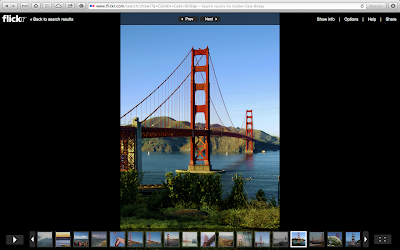The Golden Gate Bridge is a suspension bridge in San Francisco, California. The bridge extends across the Golden Gate, the opening of the San Francisco Bay into the Pacific Ocean. The bridge was constructed between January 5, 1933 and April 19, 1937. It opened to traffic on May 27, 1937. The bridge is used by about 120,000 vehicles a day.
 |
| From the Wikimedia Commons. Retouched. |
 |
| From the Wikimedia Commons. Retouched. |
Fotopedia had some jaw-dropping, gorgeous photographs of the Golden Gate Bridge.
Flickr’s collection, while extensive, paled in comparison to Fotopedia’s.
While the Golden Gate Bridge did have an official website, the website was sparse and information on the bridge was scattered across several pages. Wikipedia was the best source of information I found.
The Golden Gate Bridge is a beautiful architectural feat. It stands as an iconic symbol of both San Francisco and the United States.




















































